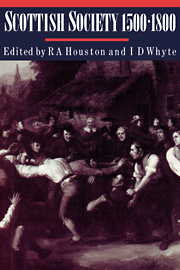Book contents
- Frontmatter
- Contents
- List of tables
- Notes on contributors
- List of abbreviations
- Introduction: Scottish society in perspective
- 1 Population mobility in early modern Scotland
- 2 Scottish food and Scottish history, 1500–1800
- 3 Continuity and change in urban society, 1500–1700
- 4 Women in the economy and society of Scotland, 1500–1800
- 5 Social responses to agrarian ‘improvement’: the Highland and Lowland clearances in Scotland
- 6 ‘Pretense of blude’ and ‘place of thair dwelling’: the nature of highland clans, 1500–1745
- 7 North and south: the development of the gulf in Poor Law practice
- 8 Scotland and Ireland, 1600–1800: their role in the evolution of British society
- 9 Kindred adjoining kingdoms: an English perspective on the social and economic history of early modern Scotland
- Bibliography of printed sources and secondary works
- Index
7 - North and south: the development of the gulf in Poor Law practice
Published online by Cambridge University Press: 08 March 2010
- Frontmatter
- Contents
- List of tables
- Notes on contributors
- List of abbreviations
- Introduction: Scottish society in perspective
- 1 Population mobility in early modern Scotland
- 2 Scottish food and Scottish history, 1500–1800
- 3 Continuity and change in urban society, 1500–1700
- 4 Women in the economy and society of Scotland, 1500–1800
- 5 Social responses to agrarian ‘improvement’: the Highland and Lowland clearances in Scotland
- 6 ‘Pretense of blude’ and ‘place of thair dwelling’: the nature of highland clans, 1500–1745
- 7 North and south: the development of the gulf in Poor Law practice
- 8 Scotland and Ireland, 1600–1800: their role in the evolution of British society
- 9 Kindred adjoining kingdoms: an English perspective on the social and economic history of early modern Scotland
- Bibliography of printed sources and secondary works
- Index
Summary
INTRODUCTION
Western Europe saw a widespread move in the later sixteenth and seventeenth centuries to replace the basis of charity and support of the poor, hitherto carried by religious bodies and charitable individuals, with a wider and better-organised system of support and control, whether by a city or by a state. In Protestant countries this was an evident need, since the secularisation of monastic property had removed an important if erratic source of alms, and the doctrinal devaluation of good works discouraged private almsgiving. Attempts to provide civic or national structures of relief involved a clearer definition of the poor: the word ‘poor’ had always meant the less favoured part of society, and continued to, but it also came to mean more specifically people whose need of help was recognised and categorised, whom a later age would label ‘objects of charity’ and a still later one ‘paupers’. In England by the mid sixteenth century a distinction was used between those recognised as suitable for charity and ‘sturdy beggars’, but those who begged were not clearly marked off in most people's minds from poor householders. In the 1570s, unemployment was recognised as a reason for destitution, and by the time of the dearth of the 1590s it was clearly seen in England that there was a class of poor householders who needed help in times of scarcity.
THE ORIGINS OF THE OLD SCOTTISH POOR LAW
In Scotland there had, from the twelfth century, been statutes which encouraged the gift of alms and the provision of justice to the poor.
- Type
- Chapter
- Information
- Scottish Society, 1500–1800 , pp. 199 - 225Publisher: Cambridge University PressPrint publication year: 1989
- 4
- Cited by



